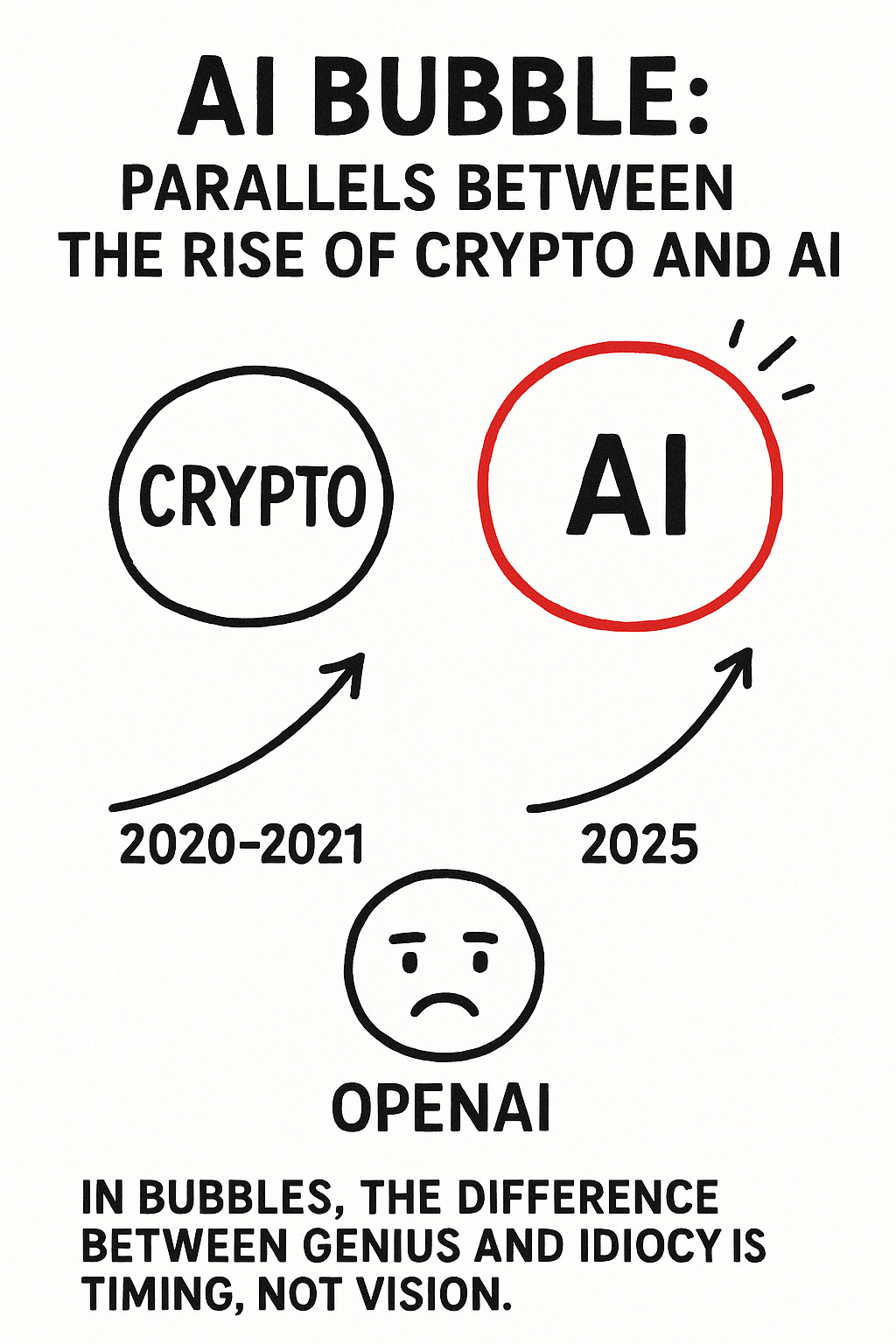AI Bubble: Parallels Between the Rise of Crypto and AI
AI is real but so is the bubble. Explore how today’s AI boom mirrors crypto’s rise and fall, and what it teaches us about hype, value and timing.
I’ll admit it. I was burned pretty badly during the last Crypto meltdown in 2022.
Caught up in the hype, I failed to see the signs of a bubble.
So when I see today’s sudden surge in AI investments, with valuations that defy gravity and startups commanding billion-dollar valuations before turning a dollar of profit… I get déjà vu.
In 2020–2021, crypto promised to revolutionise finance (and retail, gaming, art, and almost everything under the sun!).
In 2025, AI promises to revolutionise everything else.
The parallel is uncomfortable, and that got me thinking.
Between $3–6 trillion has already been poured into AI infrastructure and software, while 20,000 cryptocurrencies still carry a $5.8 trillion valuation. Combined, those two bets exceed a quarter of global GDP.
The question isn’t whether AI will matter. It’s whether the velocity of capital allocation has already exceeded the velocity of value creation.
To make things clear. Examining the parallels between crypto winter (2021–2022) and today’s AI boom isn’t about dismissing AI at all. For those who know me, you’d know how big an AI proponent I am.
This is about understanding how revolutionary technologies can be suffocated by the very capital meant to fuel them.
Setting the Stage: A Familiar Surge
In Q1 2025, AI startups absorbed 57.9% of all venture funding. This represents $73.1 billion in a single quarter, up from 22% just three years ago.
Meanwhile, 80% of U.S. stock market gains this year came from ten AI-dominant companies worth a combined $35 trillion, nearly half of the total market cap.
Hyperscalers are spending like there’s no tomorrow: Amazon ($100B), Meta ($600B over three years), Microsoft ($80B), Google ($75B), Apple ($500B), all building billion-dollar data centers faster than permits can be approved.
It’s breathtaking. It’s also eerily familiar. We’ve seen this movie: Crypto Winter.
Bitcoin down 70%. Ethereum down 71%.
Speculative excess wrapped in revolutionary storytelling.
Technology was never the problem. Speculation was.
Act I: The Math That Doesn’t Math
OpenAI reportedly processes $1 trillion in transactions, is building a $500B data center project, and still loses $13.5B on $4.3B revenue, a 314% loss-to-revenue ratio.
JPMorgan estimates the AI sector would need **$650 billion in annual revenue** to justify its current valuations.
That’s $34.72 a month from every iPhone user or $180 from every Netflix subscriber just to break even.
Yet AI startups trade at 21× ARR, while Palantir sits at a 700× P/E ratio.
And 70% of new venture funds launched this year mention “AI” in their name. Sound familiar?
In 2017, companies added “blockchain” to their names and their stocks doubled overnight.
In 2025, “AI-driven” is the new “.com.”
Act II: Ghost Buildings, Redux
AI’s physical infrastructure build-out is mirroring crypto’s mining mania.
Billions are being spent on data centers that may outpace demand, just as Bitcoin miners once built server farms that now sit idle.
Even Sam Altman and Satya Nadella have cautioned against overcapacity.
Permitting delays, grid bottlenecks, and limited AI ROI hint that we’re building the rails faster than the trains can run.
The 2000s telecom bubble taught us this: you can lay too much fiber before the customers show up.
The machinery hums, but the economics die.
Act III: When Winners Write the Rules
Eighty percent of the market’s gains come from ten companies. This concentrates the points of failure. When everyone piles into the same few names, diversification becomes an illusion.
In crypto, concentration and interconnectedness weaponised contagion. When Terra’s stablecoin collapsed, it dragged Celsius, Three Arrows Capital, and FTX down with it.
Today, AI’s interconnected ecosystem (compute, cloud, chips, models, applications) could exhibit the same fragility.
If confidence cracks, everything shakes.
Act IV: Even the Grown-Ups Are Nervous
This time, it’s not Reddit traders pushing the bubble, but it’s institutional capital.
Endowments, hedge funds, and sovereign wealth funds feel compelled to participate out of competitive paranoia: “What if my rival discovers the killer AI use case before I do?”
But even the grown-ups are uneasy. JPMorgan warns of unrealistic returns.
Economists like Jared Bernstein call the gap between earnings and investment “bubble-like.”
And if this collapses, we’re not talking crypto-scale pain, we’re talking $20 trillion in market value erased.
Act V: The Hype-to-Hardware Trap
Every technological revolution creates over-investment. Think back to railroads, telecoms, and the internet.
But AI’s version fuses hardware, software, and infrastructure in a way that magnifies the stakes.
Unlike crypto, AI has real products, real adoption, and real utility. But revenue and valuation still live on different planets.
When hype becomes hardware, the fall becomes physical. You can’t “pivot” a $500B data center.
Final Thoughts: The Uncomfortable Truth
AI is real. The bubble is too. One doesn’t cancel out the other. The technology can be revolutionary while the investment thesis is temporarily insane.
Railroads transformed the world, and their stocks still crashed.
The internet reshaped humanity, and dot-com equities fell 80%.
AI will reshape everything, and AI equities might still crater.
This isn’t cynicism. It’s pattern recognition.
In bubbles, the difference between genius and idiocy is timing, not vision.
For founders, investors, and growth leaders, the playbook is simple:
Focus on adoption, not hype.
Build for utility, not valuation.
And remember — the winners of tomorrow are rarely the loudest evangelists of today.
AI’s revolution is inevitable. Whether it becomes a boom or a bust first, that’s up to how wisely we allocate belief, not just capital.

